Input interpretation

HCl hydrogen chloride + FeCl_2 iron(II) chloride + KClO_4 potassium perchlorate ⟶ H_2O water + Cl_2 chlorine + KCl potassium chloride + FeCl_3 iron(III) chloride
Balanced equation
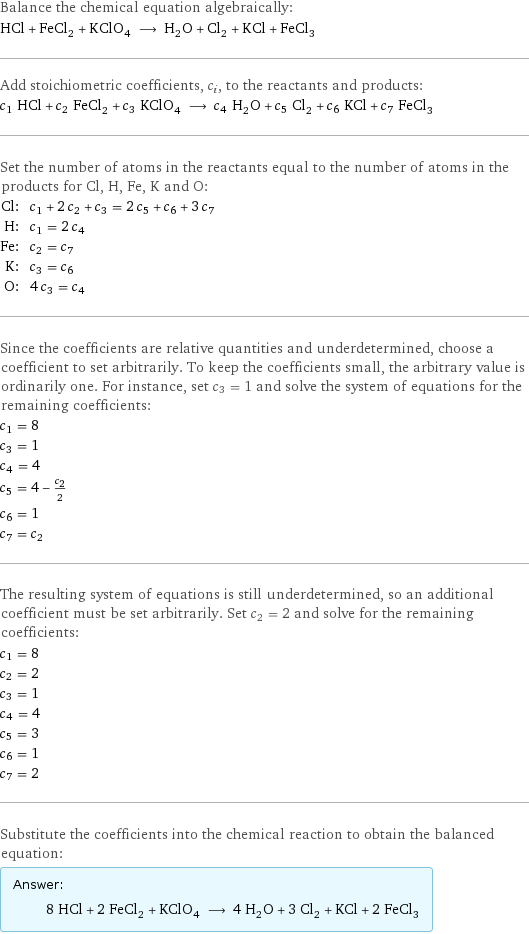
Balance the chemical equation algebraically: HCl + FeCl_2 + KClO_4 ⟶ H_2O + Cl_2 + KCl + FeCl_3 Add stoichiometric coefficients, c_i, to the reactants and products: c_1 HCl + c_2 FeCl_2 + c_3 KClO_4 ⟶ c_4 H_2O + c_5 Cl_2 + c_6 KCl + c_7 FeCl_3 Set the number of atoms in the reactants equal to the number of atoms in the products for Cl, H, Fe, K and O: Cl: | c_1 + 2 c_2 + c_3 = 2 c_5 + c_6 + 3 c_7 H: | c_1 = 2 c_4 Fe: | c_2 = c_7 K: | c_3 = c_6 O: | 4 c_3 = c_4 Since the coefficients are relative quantities and underdetermined, choose a coefficient to set arbitrarily. To keep the coefficients small, the arbitrary value is ordinarily one. For instance, set c_3 = 1 and solve the system of equations for the remaining coefficients: c_1 = 8 c_3 = 1 c_4 = 4 c_5 = 4 - c_2/2 c_6 = 1 c_7 = c_2 The resulting system of equations is still underdetermined, so an additional coefficient must be set arbitrarily. Set c_2 = 2 and solve for the remaining coefficients: c_1 = 8 c_2 = 2 c_3 = 1 c_4 = 4 c_5 = 3 c_6 = 1 c_7 = 2 Substitute the coefficients into the chemical reaction to obtain the balanced equation: Answer: | | 8 HCl + 2 FeCl_2 + KClO_4 ⟶ 4 H_2O + 3 Cl_2 + KCl + 2 FeCl_3
Structures
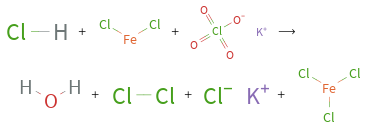
+ + ⟶ + + +
Names

hydrogen chloride + iron(II) chloride + potassium perchlorate ⟶ water + chlorine + potassium chloride + iron(III) chloride
Reaction thermodynamics
Enthalpy

| hydrogen chloride | iron(II) chloride | potassium perchlorate | water | chlorine | potassium chloride | iron(III) chloride molecular enthalpy | -92.3 kJ/mol | -341.8 kJ/mol | -432.8 kJ/mol | -285.8 kJ/mol | 0 kJ/mol | -436.5 kJ/mol | -399.5 kJ/mol total enthalpy | -738.4 kJ/mol | -683.6 kJ/mol | -432.8 kJ/mol | -1143 kJ/mol | 0 kJ/mol | -436.5 kJ/mol | -799 kJ/mol | H_initial = -1855 kJ/mol | | | H_final = -2379 kJ/mol | | | ΔH_rxn^0 | -2379 kJ/mol - -1855 kJ/mol = -524 kJ/mol (exothermic) | | | | | |
Gibbs free energy
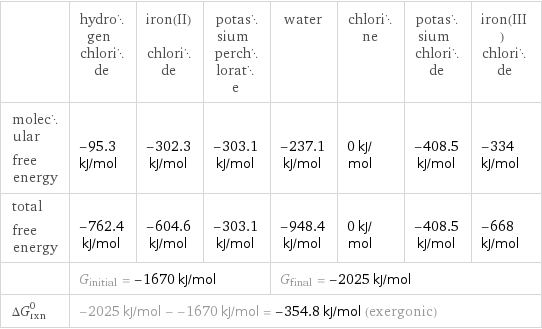
| hydrogen chloride | iron(II) chloride | potassium perchlorate | water | chlorine | potassium chloride | iron(III) chloride molecular free energy | -95.3 kJ/mol | -302.3 kJ/mol | -303.1 kJ/mol | -237.1 kJ/mol | 0 kJ/mol | -408.5 kJ/mol | -334 kJ/mol total free energy | -762.4 kJ/mol | -604.6 kJ/mol | -303.1 kJ/mol | -948.4 kJ/mol | 0 kJ/mol | -408.5 kJ/mol | -668 kJ/mol | G_initial = -1670 kJ/mol | | | G_final = -2025 kJ/mol | | | ΔG_rxn^0 | -2025 kJ/mol - -1670 kJ/mol = -354.8 kJ/mol (exergonic) | | | | | |
Equilibrium constant
![Construct the equilibrium constant, K, expression for: HCl + FeCl_2 + KClO_4 ⟶ H_2O + Cl_2 + KCl + FeCl_3 Plan: • Balance the chemical equation. • Determine the stoichiometric numbers. • Assemble the activity expression for each chemical species. • Use the activity expressions to build the equilibrium constant expression. Write the balanced chemical equation: 8 HCl + 2 FeCl_2 + KClO_4 ⟶ 4 H_2O + 3 Cl_2 + KCl + 2 FeCl_3 Assign stoichiometric numbers, ν_i, using the stoichiometric coefficients, c_i, from the balanced chemical equation in the following manner: ν_i = -c_i for reactants and ν_i = c_i for products: chemical species | c_i | ν_i HCl | 8 | -8 FeCl_2 | 2 | -2 KClO_4 | 1 | -1 H_2O | 4 | 4 Cl_2 | 3 | 3 KCl | 1 | 1 FeCl_3 | 2 | 2 Assemble the activity expressions accounting for the state of matter and ν_i: chemical species | c_i | ν_i | activity expression HCl | 8 | -8 | ([HCl])^(-8) FeCl_2 | 2 | -2 | ([FeCl2])^(-2) KClO_4 | 1 | -1 | ([KClO4])^(-1) H_2O | 4 | 4 | ([H2O])^4 Cl_2 | 3 | 3 | ([Cl2])^3 KCl | 1 | 1 | [KCl] FeCl_3 | 2 | 2 | ([FeCl3])^2 The equilibrium constant symbol in the concentration basis is: K_c Mulitply the activity expressions to arrive at the K_c expression: Answer: | | K_c = ([HCl])^(-8) ([FeCl2])^(-2) ([KClO4])^(-1) ([H2O])^4 ([Cl2])^3 [KCl] ([FeCl3])^2 = (([H2O])^4 ([Cl2])^3 [KCl] ([FeCl3])^2)/(([HCl])^8 ([FeCl2])^2 [KClO4])](../image_source/69de1fddf842f842efc5e67c04a2a526.png)
Construct the equilibrium constant, K, expression for: HCl + FeCl_2 + KClO_4 ⟶ H_2O + Cl_2 + KCl + FeCl_3 Plan: • Balance the chemical equation. • Determine the stoichiometric numbers. • Assemble the activity expression for each chemical species. • Use the activity expressions to build the equilibrium constant expression. Write the balanced chemical equation: 8 HCl + 2 FeCl_2 + KClO_4 ⟶ 4 H_2O + 3 Cl_2 + KCl + 2 FeCl_3 Assign stoichiometric numbers, ν_i, using the stoichiometric coefficients, c_i, from the balanced chemical equation in the following manner: ν_i = -c_i for reactants and ν_i = c_i for products: chemical species | c_i | ν_i HCl | 8 | -8 FeCl_2 | 2 | -2 KClO_4 | 1 | -1 H_2O | 4 | 4 Cl_2 | 3 | 3 KCl | 1 | 1 FeCl_3 | 2 | 2 Assemble the activity expressions accounting for the state of matter and ν_i: chemical species | c_i | ν_i | activity expression HCl | 8 | -8 | ([HCl])^(-8) FeCl_2 | 2 | -2 | ([FeCl2])^(-2) KClO_4 | 1 | -1 | ([KClO4])^(-1) H_2O | 4 | 4 | ([H2O])^4 Cl_2 | 3 | 3 | ([Cl2])^3 KCl | 1 | 1 | [KCl] FeCl_3 | 2 | 2 | ([FeCl3])^2 The equilibrium constant symbol in the concentration basis is: K_c Mulitply the activity expressions to arrive at the K_c expression: Answer: | | K_c = ([HCl])^(-8) ([FeCl2])^(-2) ([KClO4])^(-1) ([H2O])^4 ([Cl2])^3 [KCl] ([FeCl3])^2 = (([H2O])^4 ([Cl2])^3 [KCl] ([FeCl3])^2)/(([HCl])^8 ([FeCl2])^2 [KClO4])
Rate of reaction
![Construct the rate of reaction expression for: HCl + FeCl_2 + KClO_4 ⟶ H_2O + Cl_2 + KCl + FeCl_3 Plan: • Balance the chemical equation. • Determine the stoichiometric numbers. • Assemble the rate term for each chemical species. • Write the rate of reaction expression. Write the balanced chemical equation: 8 HCl + 2 FeCl_2 + KClO_4 ⟶ 4 H_2O + 3 Cl_2 + KCl + 2 FeCl_3 Assign stoichiometric numbers, ν_i, using the stoichiometric coefficients, c_i, from the balanced chemical equation in the following manner: ν_i = -c_i for reactants and ν_i = c_i for products: chemical species | c_i | ν_i HCl | 8 | -8 FeCl_2 | 2 | -2 KClO_4 | 1 | -1 H_2O | 4 | 4 Cl_2 | 3 | 3 KCl | 1 | 1 FeCl_3 | 2 | 2 The rate term for each chemical species, B_i, is 1/ν_i(Δ[B_i])/(Δt) where [B_i] is the amount concentration and t is time: chemical species | c_i | ν_i | rate term HCl | 8 | -8 | -1/8 (Δ[HCl])/(Δt) FeCl_2 | 2 | -2 | -1/2 (Δ[FeCl2])/(Δt) KClO_4 | 1 | -1 | -(Δ[KClO4])/(Δt) H_2O | 4 | 4 | 1/4 (Δ[H2O])/(Δt) Cl_2 | 3 | 3 | 1/3 (Δ[Cl2])/(Δt) KCl | 1 | 1 | (Δ[KCl])/(Δt) FeCl_3 | 2 | 2 | 1/2 (Δ[FeCl3])/(Δt) (for infinitesimal rate of change, replace Δ with d) Set the rate terms equal to each other to arrive at the rate expression: Answer: | | rate = -1/8 (Δ[HCl])/(Δt) = -1/2 (Δ[FeCl2])/(Δt) = -(Δ[KClO4])/(Δt) = 1/4 (Δ[H2O])/(Δt) = 1/3 (Δ[Cl2])/(Δt) = (Δ[KCl])/(Δt) = 1/2 (Δ[FeCl3])/(Δt) (assuming constant volume and no accumulation of intermediates or side products)](../image_source/1f845cec07eda76e4ea5b43ac04a2a5a.png)
Construct the rate of reaction expression for: HCl + FeCl_2 + KClO_4 ⟶ H_2O + Cl_2 + KCl + FeCl_3 Plan: • Balance the chemical equation. • Determine the stoichiometric numbers. • Assemble the rate term for each chemical species. • Write the rate of reaction expression. Write the balanced chemical equation: 8 HCl + 2 FeCl_2 + KClO_4 ⟶ 4 H_2O + 3 Cl_2 + KCl + 2 FeCl_3 Assign stoichiometric numbers, ν_i, using the stoichiometric coefficients, c_i, from the balanced chemical equation in the following manner: ν_i = -c_i for reactants and ν_i = c_i for products: chemical species | c_i | ν_i HCl | 8 | -8 FeCl_2 | 2 | -2 KClO_4 | 1 | -1 H_2O | 4 | 4 Cl_2 | 3 | 3 KCl | 1 | 1 FeCl_3 | 2 | 2 The rate term for each chemical species, B_i, is 1/ν_i(Δ[B_i])/(Δt) where [B_i] is the amount concentration and t is time: chemical species | c_i | ν_i | rate term HCl | 8 | -8 | -1/8 (Δ[HCl])/(Δt) FeCl_2 | 2 | -2 | -1/2 (Δ[FeCl2])/(Δt) KClO_4 | 1 | -1 | -(Δ[KClO4])/(Δt) H_2O | 4 | 4 | 1/4 (Δ[H2O])/(Δt) Cl_2 | 3 | 3 | 1/3 (Δ[Cl2])/(Δt) KCl | 1 | 1 | (Δ[KCl])/(Δt) FeCl_3 | 2 | 2 | 1/2 (Δ[FeCl3])/(Δt) (for infinitesimal rate of change, replace Δ with d) Set the rate terms equal to each other to arrive at the rate expression: Answer: | | rate = -1/8 (Δ[HCl])/(Δt) = -1/2 (Δ[FeCl2])/(Δt) = -(Δ[KClO4])/(Δt) = 1/4 (Δ[H2O])/(Δt) = 1/3 (Δ[Cl2])/(Δt) = (Δ[KCl])/(Δt) = 1/2 (Δ[FeCl3])/(Δt) (assuming constant volume and no accumulation of intermediates or side products)
Chemical names and formulas
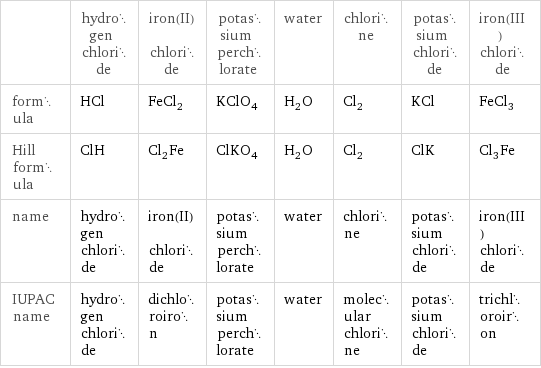
| hydrogen chloride | iron(II) chloride | potassium perchlorate | water | chlorine | potassium chloride | iron(III) chloride formula | HCl | FeCl_2 | KClO_4 | H_2O | Cl_2 | KCl | FeCl_3 Hill formula | ClH | Cl_2Fe | ClKO_4 | H_2O | Cl_2 | ClK | Cl_3Fe name | hydrogen chloride | iron(II) chloride | potassium perchlorate | water | chlorine | potassium chloride | iron(III) chloride IUPAC name | hydrogen chloride | dichloroiron | potassium perchlorate | water | molecular chlorine | potassium chloride | trichloroiron
Substance properties
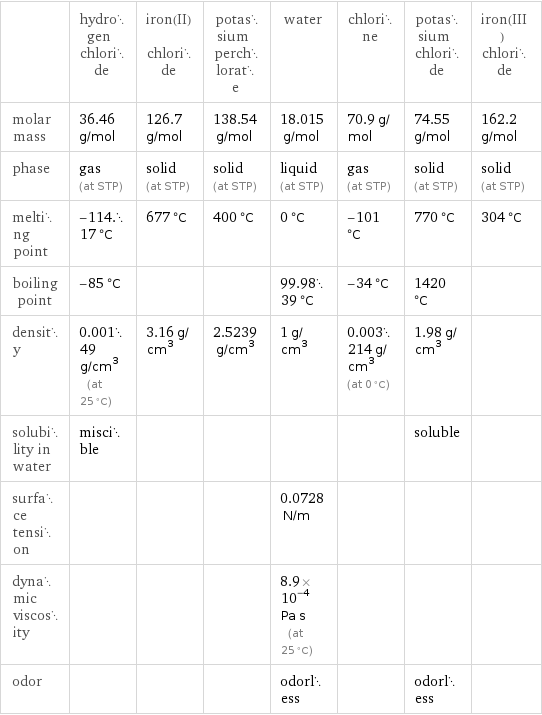
| hydrogen chloride | iron(II) chloride | potassium perchlorate | water | chlorine | potassium chloride | iron(III) chloride molar mass | 36.46 g/mol | 126.7 g/mol | 138.54 g/mol | 18.015 g/mol | 70.9 g/mol | 74.55 g/mol | 162.2 g/mol phase | gas (at STP) | solid (at STP) | solid (at STP) | liquid (at STP) | gas (at STP) | solid (at STP) | solid (at STP) melting point | -114.17 °C | 677 °C | 400 °C | 0 °C | -101 °C | 770 °C | 304 °C boiling point | -85 °C | | | 99.9839 °C | -34 °C | 1420 °C | density | 0.00149 g/cm^3 (at 25 °C) | 3.16 g/cm^3 | 2.5239 g/cm^3 | 1 g/cm^3 | 0.003214 g/cm^3 (at 0 °C) | 1.98 g/cm^3 | solubility in water | miscible | | | | | soluble | surface tension | | | | 0.0728 N/m | | | dynamic viscosity | | | | 8.9×10^-4 Pa s (at 25 °C) | | | odor | | | | odorless | | odorless |
Units
